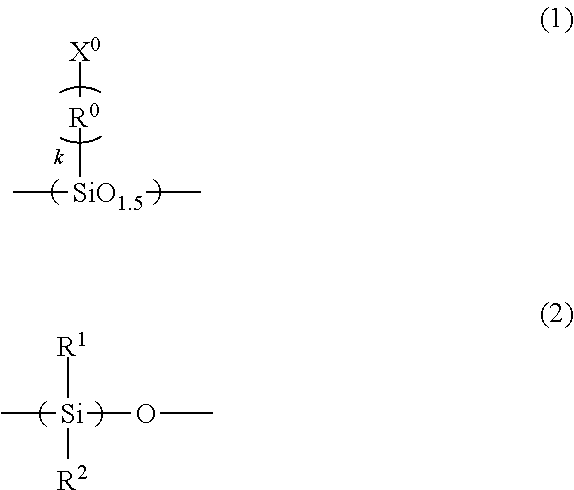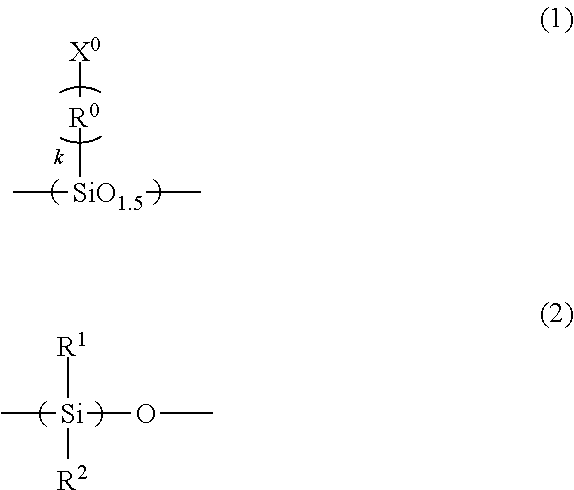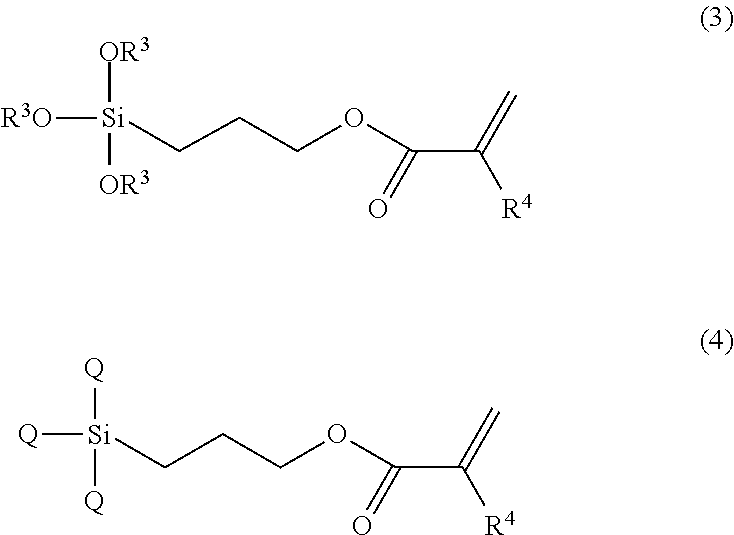Imprint material containing silsesquioxane compound and modified silicone compound
a technology of modified silicone and silsesquioxane, which is applied in the field of imprint materials, can solve the problems of contaminated inside devices, equipment for producing devices, and molds that are required for a longer operating life, and achieve excellent pattern formation of photo-imprints, low mold release force properties, and high transparency
- Summary
- Abstract
- Description
- Claims
- Application Information
AI Technical Summary
Benefits of technology
Problems solved by technology
Method used
Image
Examples
synthesis example 1
[0099]Into a 2,000 mL four-necked flask, 486.98 g of 3-acryloyloxypropyltrimethoxysilane and 400.53 g of methanol were charged and the mixture was cooled to 10° C. with stirring. To the mixture, a mixed solution of 112.23 g of 0.1N hydrochloric acid aqueous solution and 200.26 g of methanol was added dropwise over a period of 30 minutes at 10° C. to 25° C. Thereafter, the solution was stirred at room temperature for 1 hour and stirred with refluxing for 3 hours. The solution was concentrated under reduced pressure while adding 820 g of propylene glycol monomethyl ether acetate (hereinafter abbreviated as PGMEA in this specification) to the solution to replace the solution to a PGMEA solution and thus 600.0 g of the PGMEA solution of the silsesquioxane compound was obtained. To this PGMEA solution of the silsesquioxane compound, 120.0 g of propylene glycol monomethyl ether (hereinafter abbreviated as PGME in this specification) and the resultant mixture was heated at 40° C. for 2 hou...
example 1
[0101]9.5 g of AC-SQ TA-100 (manufactured by Toagosei Co., Ltd.) (hereinafter abbreviated as “AC-SQTA-100” in this specification), 0.5 g of X-22-1602 (manufactured by Shin-Etsu Chemical Co., Ltd.) (hereinafter abbreviated as “X-22-1602” in this specification), 0.25 g of Lucirin (registered trademark) TPO (manufactured by BASF Japan Ltd.) (hereinafter abbreviated as “Lucirin TPO” in this specification) (2.5 phr with respect to the total amount of AC-SQ TA-100 and X-22-1602), and 19 g of ethyl pyruvate were mixed to prepare an imprint material PNI-a1. In this Example, the ratio of the amount of the (B) component to the total amount of AC-SQ TA-100 corresponding to the (A) component and X-22-1602 corresponding to the (B) component of 100% by mass is 5% by mass.
example 2
[0102]9 g of AC-SQ TA-100, 1 g of X-22-1602, 0.25 g of Lucirin TPO (2.5 phr with respect to the total amount of AC-SQ TA-100 and X-22-1602), and 19 g of ethyl pyruvate were mixed to prepare an imprint material PNI-a2. In this Example, the ratio of the amount of the (B) component to the total amount of AC-SQ TA-100 corresponding to the (A) component and X-22-1602 corresponding to the (B) component of 100% by mass is 10% by mass.
PUM
| Property | Measurement | Unit |
|---|---|---|
| temperature | aaaaa | aaaaa |
| temperature | aaaaa | aaaaa |
| mass | aaaaa | aaaaa |
Abstract
Description
Claims
Application Information
 Login to View More
Login to View More - R&D
- Intellectual Property
- Life Sciences
- Materials
- Tech Scout
- Unparalleled Data Quality
- Higher Quality Content
- 60% Fewer Hallucinations
Browse by: Latest US Patents, China's latest patents, Technical Efficacy Thesaurus, Application Domain, Technology Topic, Popular Technical Reports.
© 2025 PatSnap. All rights reserved.Legal|Privacy policy|Modern Slavery Act Transparency Statement|Sitemap|About US| Contact US: help@patsnap.com



